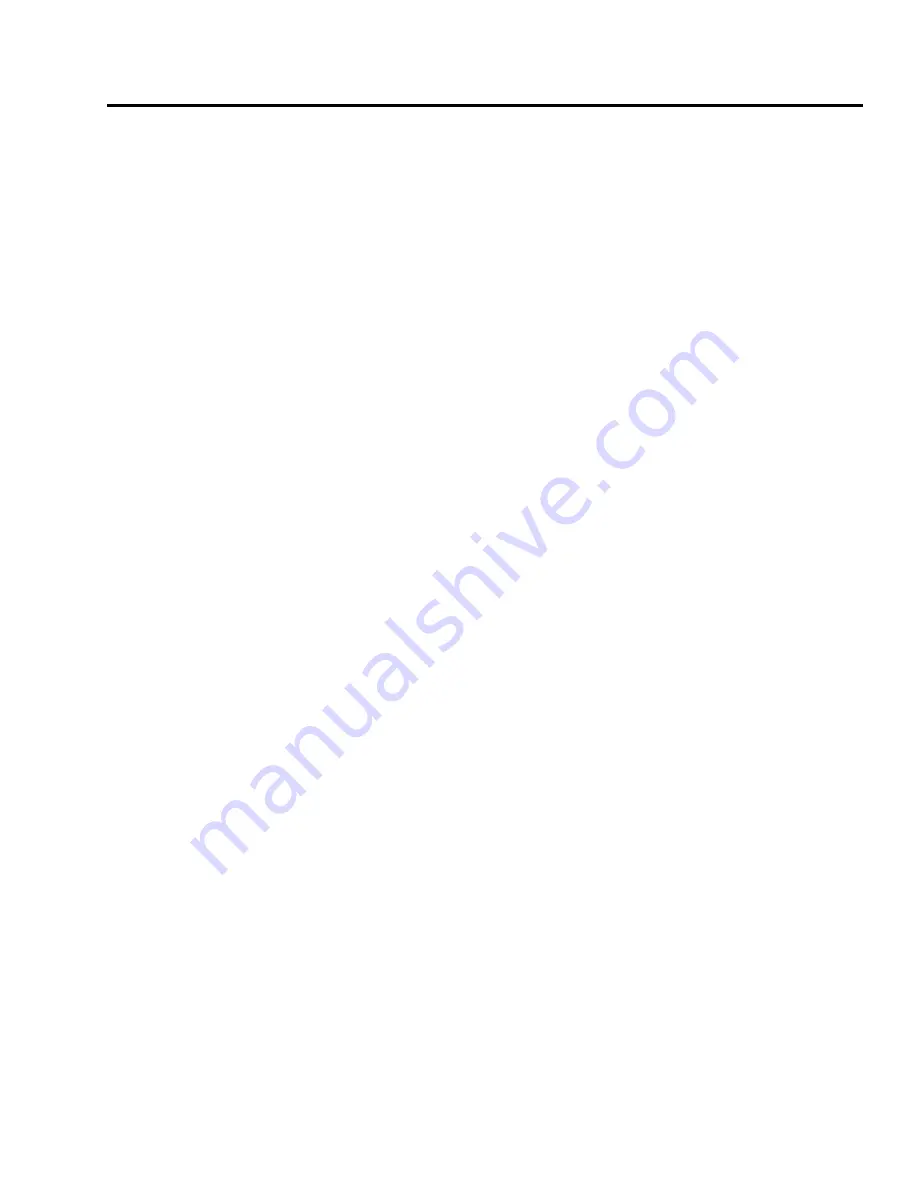
5.
Inspect for excess radial wear between the flyweight and axle using the 11-10041 flyweight gauge. Insert
the gauge between flyweights and against cam hub as shown in Figure 7414. If the gauge cannot be
inserted easily, remove burr from edges of hub keyway with a small file. Hold the gauge firmly against the
hub, at the same time squeezing the flyweights against the gauge. If the inner end of either flyweight heel
touches the gauge, replace the cam assembly. If parts are near limits, check clearance between flyweight
and gauge with a .003 inch feeler. If flyweight heel is tight on feeler, replace the cam assembly.
— CAUTION —
NEVER ATTEMPT TO REPAIR ANY PA RT OF A REJECTED CAM AND
FLYWEIGHT ASSEMBLY.
6.
Inspect ears of the coupling body for grooves worn by the tail of the flyweights and wear at the triggering
ramp and cam stop contact areas. (Refer to Figure 7415.) If either ear shows a perceptible groove or a ridge
can be felt when fingernail is drawn across the surface, replace the coupling body.
7.
Inspect drive lugs of body. If wear is noted, measure difference between worn and unworn areas on drive
lug surface. If difference is in excess of .015 of an inch, replace the body.
8.
With spring released and free, it should form a smooth spiral curve with no sharp bends or flat spots. (Refer
to Figure 7416.) If spring is deformed, replace it.
9.
Inspect spring for cracks particularly at the ends and around spring eyes. Inspect coils of spring for
excessive wear. If grooves or ridges are worn in coils or cracks are found, replace spring.
10. Inspect the housing for cracks, stripped threads or other damage. Replace if necessary.
IMPULSE COUPLING INSTALLATION.
1.
Check mating cam assembly and body for magnetization which would prevent flyweights from engaging.
Hold the assembly as shown in Figure 7417 and push upper flyweight against body. When released,
flyweight must drop down. If flyweight sticks to body, parts are magnetized and coupling may not function.
Perform test on both flyweights.
2.
To demagnetize, place body over shaft of a charged rotating magnet and spin body rapidly by hand. While
body is still spinning, invert magnet so body falls off. Catch body in hand and repeat test for magnetization.
3.
Clamp one drive lug of the body in a padded jaw vise with the spring recess side up.
4.
Orient the spring with the body for correct rotation. On clockwise couplings, the spring must coil in a
clockwise direction from the outside toward the center when viewed from the spring recess side of the body.
(Refer to Figure 7418.) Insert eye of outer end of spring into hole drilled in inner rim of body.
5.
Using heavy gloves to protect the hands, wind spring into body manually, lifting spring coils one at a time
over projections on body. Extreme care should be used to avoid scratching or nicking the spring. After
winding the spring, brush a coating of light oil over the spring coils.
6.
Pry up one and one-half turns at the inner end of the spring with a small screwdriver and support in position
as shown in Figure 7419.
7.
Engage recess in the hub on the cam assembly with eye at inner end of spring. With eye engaged, rotate
cam assembly slightly in direction to unwind spring to permit hub of cam to slip into the inner turn of the
spring. Rotate the cam in the opposite direction, winding spring slightly, until projections on edge of cam
clear over the projections on the body. Push the cam assembly down into the body, at the same time taking
the screwdriver out.
PA - 4 4 - 1 8 0 / 1 8 0 T
AIRPLANE MAINTENANCE MANUAL
7 4 - 11 - 0 6
Page 74-17
Revised: May 15, 1989
3G10
PIPER AIRCRAFT
Summary of Contents for SEMINOLE PA-44-180
Page 38: ...CHAPTER DIMENSIONS AND AREAS 1B14...
Page 49: ...CHAPTER LIFTING AND SHORING 1C1...
Page 53: ...CHAPTER LEVELING AND WEIGHING 1C5...
Page 58: ...CHAPTER TOWING AND TAXIING 1C10...
Page 62: ...CHAPTER PARKING AND MOORING 1C14...
Page 65: ...CHAPTER REQUIRED PLACARDS 1C17...
Page 70: ...CHAPTER SERVICING 1C22...
Page 98: ...CHAPTER STANDARD PRACTICES AIRFRAME 1E2...
Page 108: ...CHAPTER ENVIRONMENTAL SYSTEM 1E12...
Page 189: ...CHAPTER AUTOFLIGHT 1H21...
Page 192: ...CHAPTER COMMUNICATIONS 1H24...
Page 202: ...CHAPTER ELECTRICAL POWER 1I10...
Page 228: ...CHAPTER EQUIPMENT FURNISHINGS 1J12...
Page 233: ...CHAPTER FIRE PROTECTION 1J17...
Page 238: ...CHAPTER FLIGHT CONTROLS 1J24...
Page 304: ...2A18 CHAPTER FUEL...
Page 325: ...2B17 CHAPTER HYDRAULIC POWER...
Page 357: ...2D1 CHAPTER ICE AND RAIN PROTECTION...
Page 414: ...CHAPTER LANDING GEAR 2F13...
Page 479: ...2I6 CHAPTER LIGHTS...
Page 488: ...2I16 CHAPTER NAVIGATION AND PITOT STATIC...
Page 503: ...2J7 CHAPTER OXYGEN...
Page 524: ...2K6 CHAPTER VACUUM...
Page 535: ...2K19 CHAPTER ELECTRICAL ELECTRONIC PANELS AND MULTIPURPOSE PARTS...
Page 546: ...INTENTIONALLY LEFT BLANK PA 44 180 180T AIRPLANE MAINTENANCE MANUAL 2L6 PIPER AIRCRAFT...
Page 547: ...2L7 CHAPTER STRUCTURES...
Page 582: ...CHAPTER DOORS 3A18...
Page 593: ...CHAPTER STABILIZERS 3B8...
Page 604: ...CHAPTER WINDOWS 3B22...
Page 611: ...CHAPTER WINGS 3C10...
Page 624: ...CHAPTER PROPELLER 3D1...
Page 643: ...CHAPTER POWER PLANT 3D21...
Page 667: ...CHAPTER ENGINE FUEL SYSTEM 3F1...
Page 681: ...CHAPTER IGNITION 3F16...
Page 712: ...CHAPTER ENGINE INDICATING 3H1...
Page 730: ...CHAPTER EXHAUST 3H19...
Page 734: ...CHAPTER OIL 3I1...
Page 743: ...CHAPTER STARTING 3I11...
Page 755: ...CHAPTER TURBINES 3J1...














































